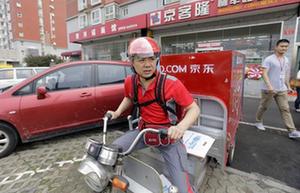Along with the rise of digital media, food retail outlets are undergoing a major shift toward online delivery. And a recent heat wave in China has pushed interest in ordering food off the Internet to all-time highs.
"Our orders jumped by 30 percent to 50 percent as a result of weather conditions this summer, including high temperatures, heavy rainfall and typhoons," said Chen Xiaofei, a public relations associate at ele.me, the largest Chinese online food ordering service, which translates to "Are you hungry?"
The FIFA World Cup 2014 tournament also gave a boost to the company's online and mobile app sales.
Orders at ele.me went up 10 percent during the month-long sporting event, climbing 20 percent higher during the hours between midnight to 6 am, according to the company.
Ele.me's development of a standardized ordering system is giving it an edge in the 50 Chinese cities where it operates.
Founded in 2009, the startup has enjoyed significant rounds of financing, with over $100 million in seed money, from such investors as dianping.com, a website that provides public reviews of restaurants.
Other firms, such as daojia.com.cn, have also witnessed an uptick in online food orders.
The Beijing-based company saw its profit double year-on-year since it was founded in 2010, and has received funding from investors such as JD.com, a leading Chinese e-commerce company.
Partnering with major chain eateries, including Quanjude Roast Duck Restaurant, South Beauty, Tous Les Jours and Haagen-Dazs, daojia.com.cn said it mainly targets families and that it sees a higher ordering volume on weekends and at dinnertime.
"The orders started to surge when the weather turned hot. Similarly, winter is also a peak season for delivery business as customers are unwilling to go out to eat," said Yang Xiaolai, marketing director at daojia.com.cn.
Yang said the delivery menus are roughly the same as eat-in menus with similar prices.
"Certain dishes, such as sushi, sashimi, seafood or bean products, are unsuitable for delivery, since they easily go bad in high temperatures. Therefore, they are not included in the delivery menus," she said.
China is expected to have nearly 300 million online-to-offline users in 2015, with a market potential of over 270 billion yuan ($44 billion), according to data from iResearch, a consulting firm that focuses on the Internet industry.
And for many Chinese netizens, ordering food online has already become a habit.
Cheng Yixiang, a student at the University of International Business and Economics, said he usually places food orders online twice a week.
"Compared with eating in the school cafeteria or at restaurants off-campus, ordering online is much more convenient, plus it saves time," Cheng said.
 |
 |
| JD.com moves to merge Tencent's e-commerce business | JD.com founder lines up next goal: beating Alibaba |
